Menus
- Daily test of the equivalent model 125 with two batteries
- 160 km of autonomy announced, 90 km / h, 4,000 watts, 171 Nm, 115 kg, 5,290 euros
- Discovery
- In the saddle
- In the city
- On the road
- Night road
- Braking
- Comfort
- Autonomy
- Recharge
- Revisions
- Convenient
- See the Supersoco Cpx scooter test in video
- Conclusion
Daily test of the equivalent model 125 with two batteries
160 km of autonomy announced, 90 km / h, 4,000 watts, 171 Nm, 115 kg, 5,290 euros
If there is one evidence on the electric market, it is the proliferation of electric scooters, which are multiplying like hot cakes ! There is not a week without us unveiling a new model, from the most improbable to the most design. Only one thing is a common denominator, at a time when more and more cities are announcing that they are banning thermal two-wheelers in city centers … it is the arrival of more and more of these two-wheelers. electric, which year after year is gaining in autonomy, speed of charge, even top speed to tackle the peri-urban and two-lane expressways. But faced with this explosion of the market, how to choose between the unknown brand and the one that evokes something. This is exactly the case with the manufacturer Super Soco who has tumbled like a UFO on the electric market by first offering small machines equivalent to 50 and then 125 with a really nice look like the TC and TC Max. And then logically, the manufacturer proposed an electric scooter with the CPx. A brand installed, that reassures. But what is this model worth on a daily basis. We took it for two weeks to really try it, solo and in duo, in town and on the ring road, even peri-urban and in the cold (thermometer to zero in the morning before leaving for the office). We tell you everything.
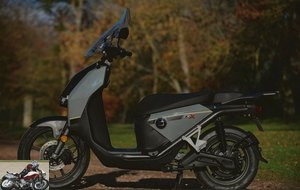 Electric scooter 125cc equivalent
Electric scooter 125cc equivalent
Discovery
The good thing about electricity is that the absence of a heat engine and batteries allow you to dare, for better or for worse. But with the CPx, we find a scooter with the usual lines including a thermal scooter. Geometric lines, a high bubble, a long two-seater saddle, an apparent frame, parquet rack, difficult to know at first glance that it is an electric scooter. You have to really get closer to discover an LCD screen and especially to note the absence of exhaust to suspect that it is an electric model..
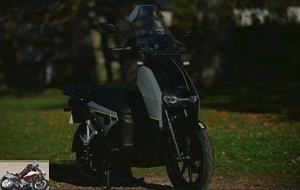 Easy to put on the center stand
Easy to put on the center stand
Under the volume generally devoted to the engine and the trunk, we find the battery (s). Because yes, it is one of the characteristics of the model, being able to be provided with one or two batteries, removable, thus making it possible to extend the autonomy, to the detriment of the storage. Because with two batteries, there is no more storage space for the blow, except the small storage compartment at the front, which allows with the USB port to recharge a smartphone.
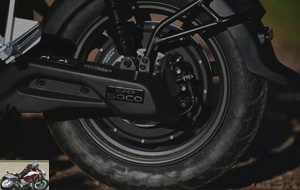 Swivel arm motor housed in the rear wheel
Swivel arm motor housed in the rear wheel
This is not visible at first glance, but Super Soco uses a Bosch motor of 4 kW (6 kW peak) which offers a maximum torque of 171 Nm, or on paper, more than many big ones. thermal displacement. All this allows to reach the 93 km / h counter.
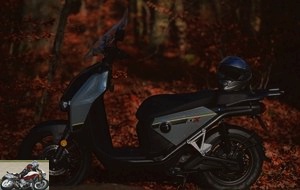 4000 Watts of maximum power
4000 Watts of maximum power
Super Soco finally announces a charging time of 4 hours per battery, each battery being able to provide approximately – on paper – 80 km of autonomy at most (at 45 km / h). Indeed, if we can do 160 km with the load, we start to have a real scooter that can start to compete with thermal. And at 4,290 euros with a battery (1,000 euros to be added to have the second battery), we are at the price level of a high-end 125 scooter.
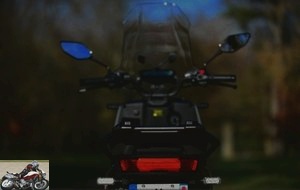 LED rear light
LED rear light
In the saddle
But why do scooter manufacturers have to offer saddles so high, even though officially the saddle is only 760mm? And in addition to the height, the saddle of the CPx is wide. Suddenly, the pilot of 1.70m has just the two ends of the feet on the ground. Fortunately, the weight felt is light and for good reason with only 114 kilos (and 133 with two batteries).
The hands fall naturally on a relatively wide handlebars. The position is then straight, natural, even if the arms are well bent and if you are quite or too close to the bubble. And there is room on it, because the saddle is so long that you could put three people on it if necessary.
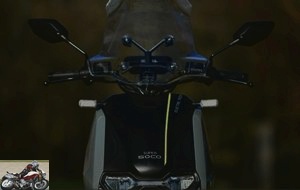 Original non-adjustable screen
Original non-adjustable screen
Under the eyes, there is a very readable LCD screen, with trip, totalizer, clock, speedometer, bar graph indicator of instantaneous power consumed and indicator of current driving mode without forgetting the percentage of charge of the battery (s). And there is also a mobile application allowing you to find information on your smartphone, except that I have not succeeded in pairing the app and the scooter and on the distribution side, the dealer confirms to me that the app does not work. Which is annoying, since suddenly, it is impossible to adjust the on-board clock. And no button to reset the trip; fortunately the trick of resetting the partial trip is through six calls of the headlight (using the crossing / road button).
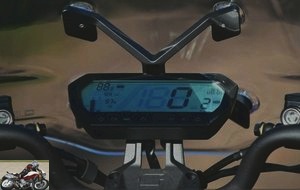 LCD dashboard, changing night and day
LCD dashboard, changing night and day
On the right stalk, there is a button for selecting three modes, 1, 2 or 3, limiting the maximum speed, mode 1 being the "Eco" mode. And there is also a forward (F) and reverse (A) mode, to facilitate parking for example.
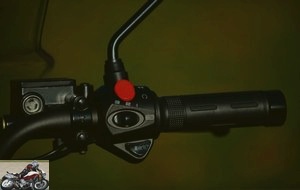 Power mode selection (3-2-1) while driving + reverse / forward mode (below)
Power mode selection (3-2-1) while driving + reverse / forward mode (below)
The mirrors rather offer a good rearview and are easily adjusted.
Ignition key inserted (or not thanks to the keyless), not without having electronically unlocked the scooter so as not to hear the alarm and let’s go. In other words, we can simply press the large main button of the key to turn on the scooter and we put the key back in the jacket then and off we go, without needing a key in the switch behind the apron..
The steering is very sensitive on the first few meters, with an enormous ease to turn, if not too much. But it helps well in maneuvers in order to slip easily between two close and narrow points, almost at a right angle. Almost looks like a bicycle.
And the scooter sets off in the greatest silence. Depending on the helmet, you can’t hear it at all. You will tell me reader that it is normal since it is an electric scooter. Yes but no. Many electric models emit that slight whistle so characteristic and here, you really have to listen (without headphones) to notice it. And this extra silence is welcome.
In the city
The reaction to the throttle is immediate and we rush off instantly. Fortunately, Super Soco offers here a couple delivering themselves as and when, allowing to have a smooth driving. There is nothing worse than a violent scooter when starting and asking to dose the handle. Nothing like this here, or even by turning the handle suddenly, the start is clean but not violent, whatever the mode. Because if in theory, there is a different setting depending on the mode, during testing and even being careful, we do not feel a difference at start-up between the 3 possible modes. In fact, in feeling, the three modes only determine the maximum speed and therefore mainly influence the maximum possible autonomy. Starts are therefore straightforward but without violence to quickly reach 50 km / h, in mode 2 or 3. In mode 1, you will be limited to 45 km / h on the other hand, which is sufficient in town. The decelerations are gentle where the scooter gives the impression of being coasting more than on certain electric scooters where there is an engine braking / energy recovery effect. Smoother and smooth driving is therefore pleasant on a daily basis..
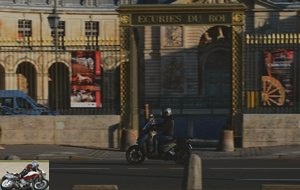 Pleasant and gentle in town
Pleasant and gentle in town
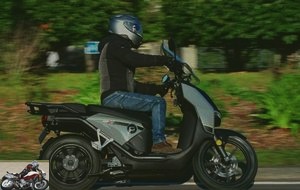 Ease of handling and maneuverability on the road
Ease of handling and maneuverability on the road
On the road
We can quickly reach 60 km / h then 70 km / h well launched in mode 2 and we can let go of the cavalry in mode 3. It is then possible to reach a good 80 km / h on the flat without forcing. And well launched downhill, the odometer even manages to indicate a 101 km / h! But from day to day and even more in duo, it is better to count on the 80 km / h than the 90 km / h … and still on the flat. Because if the odds arrive, the speed will drop as drastically as with a thermal scooter and even more in duo. I have two "standard" ribs around my home, one or many 125 scooters top out at 70 km / h and another where they top out at 60 km / h at best. The CPx hits 70 km / h on the first and 50 km / h on the second, solo (and with 10 km / h less in duo) and doing the charged batteries test, that is to say when they have their maximum available power.
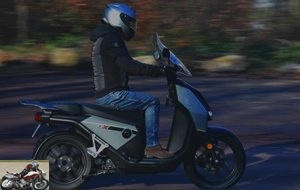 70 km / h in mode 2
70 km / h in mode 2
And then the duet and full ratings melt the drums visibly !
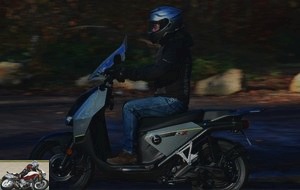 93 km / h (odometer) in mode 3 well started
93 km / h (odometer) in mode 3 well started
Moreover, as much as 70 km / h can be reached in mode 2 when the battery is well charged, it will be 67 or even 65 km / h in duo then when half the battery is down and just 60 km / h when the battery drops below 30%. We will therefore rather rely on a 60 km / h easily, a higher speed being reached only in the right conditions. But mode 2 remains the sufficient one in town, while saving autonomy.
The high bubble is very effective, but generates noise in the headphones. We would like to lower it, even if the gaze passes just above.
Night road
The low beams are aesthetic with a nice light signature but will be especially useful in town. Once, in the open countryside in complete darkness, the high beams are essential with a significantly longer range, but without excess. A motorcycle will be more efficient at night even if given the maximum speed of the scooter, it will be sufficient.
Braking
The levers are a bit far and hard and not adjustable in spacing. Small hands may thus be hampered. We got used to it, but an adjustment possibility for small hands would have been welcome. In the meantime, it brakes very well and hard, even with two fingers, despite a single 240 mm disc at the front (and a single 180 mm disc at the rear), with power for lack of feeling. You can even block the rear by really taking the brake if the road is wet (solo but not in duo on the other hand). But if we use both brakes simultaneously, it is impossible to trigger the ABS and for good reason, there is none since we have here a combined front and rear CBS braking..
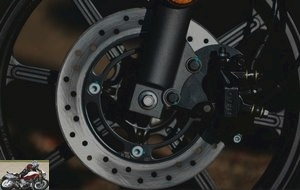 Disc Ш 240 mm at the front
Disc Ш 240 mm at the front
Comfort
Beyond its look and finish, the saddle is wide and comfortable. Afterwards, the comfort is rather firm and you can really feel the cobblestones. Suddenly, it is better to slow down before the backs of donkeys, under penalty of jumping on the saddle..
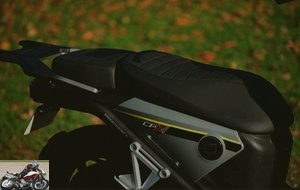 A long double saddle, even triple saddle, comfortable
A long double saddle, even triple saddle, comfortable
Autonomy
In general, we switch to the second battery after 40 km … with a small intermediate passage a little limited in performance. And with the increased acceleration, you instantly feel that you have automatically switched to the second battery..
We were scared at first, because the two batteries were 99% charged when the scooter was taken. The gauge of one of the batteries then drops steadily, soon joined by the second. And 50 km further, while we are at 20% of remaining battery charge, we fall into "reduced" mode … and there, you drive barely faster than a pedestrian, without the possibility of forcing even a few hundred meters in more powerful mode. The speedometer stops indicating the speed on the speedometer at this time. It is better not to be on the ring road at this time. On the other hand, I was several kilometers from home when it happened and at turtle speed, when I arrived home, there was still 17% battery life. So at least there is no need to push (especially since it was dark and cold).
It is therefore necessary to do the test from 100%, because the 1% difference can mean more than ten kilometers of difference in autonomy. Well charged, the first battery is discharged after 40 km, having used only mode 2 (not mode 3) but in duo. We then automatically switch to the second battery if it is available. And it is only from that moment that the percentage decreases. That is, the indicator kept showing 99% as long as the first battery was draining while only the battery symbol was going low. Once passed on the second battery, only then the indicator indicates the percentage of charge remaining (while the first battery flashes with two sticks remaining). After 80 km, we fall below 20%, the two gauges / batteries start to flash to indicate the need for recharging. It is then the maximum speed which decreases gradually, to descend to 40 km / h, then 30 km / h (under 10%) without renewing the degraded mode experienced the first time. We then made 90 km and at slower speed, it is possible to do 100 km, with two batteries
To be precise, my trip has a lot of red lights (and therefore many stops / starts) and odds and as many descents, putting under stress the batteries compared to use in town on flat ground. This is a real test condition and not the maximum possible autonomy, flat, non-stop and solo.
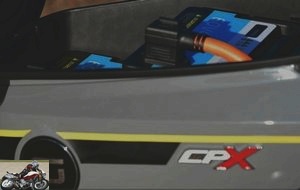 Up to two ATL Lithium-ion batteries under the saddle to double the range
Up to two ATL Lithium-ion batteries under the saddle to double the range
Recharge
It is possible to recharge from the outside, or to lift the saddle to charge each battery independently (not without having turned the circuit breaker off) on the charger supplied. The charge indication is shown via 5 diodes on the battery, but not on the meter as one would expect. This is sufficient, but without precision. Super Soco announces 3 hours of charging. During the first charge, after 3 hours, only 3/5 of the diodes were on. And it actually took 6 hours to charge a battery, even if after 5 hours, the dashboard displays 99% charged. Because the remaining 1% represents a lot of kilometers in reality and you should not hesitate to leave an hour more. The second battery also took six hours to recharge. And you cannot charge both batteries at the same time (unless you have two chargers), thus not allowing to charge in the evening while being sure that everything is charged in the morning. On the other hand, once the battery is charged, the red led on the charger turns green and the flashing diodes on the battery go out. We also dream of an indicator of remaining charge time. And then, all subsequent other charges were done in 3 hours per battery. The scooter being new, probably it is the first charges that are longer.
Note that the charger is noisy with a real hum, which leads to charging more in the garage than at home. In any case, the battery is heavy (19 kilos) and you have to accept to carry this weight, especially if you do not have an elevator, even if it remains possible.
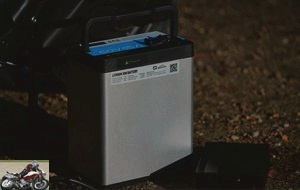 ATL 60V 45A Lithium-ion battery of 2.7 kWh, transportable (19 kilos)
ATL 60V 45A Lithium-ion battery of 2.7 kWh, transportable (19 kilos)
The batteries are guaranteed for 1,500 cycles and two years.
Revisions
There is a service every 6,000 kilometers, in addition to the regular tire pressure check, knowing that every 6,000 kilometers these are mainly wear checks (pads and discs).
Convenient
There is a small open pocket at the front to charge a smartphone using the USB socket.
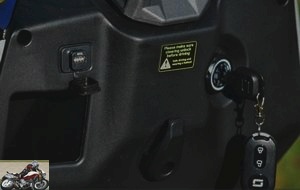 Open pocket to recharge the smartphone, just under the USB socket
Open pocket to recharge the smartphone, just under the USB socket
The bubble offers excellent protection and is not annoying at any time.
There is room under the saddle (20 liters normally), when there is only one battery connected, but not enough to put a jet. And when there are two batteries, there is no more room.
The rack is long and wide, helped by a flat floor to put groceries, helped by a small hook to hang everything. And this is the storage advantage of this scooter.
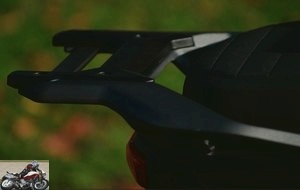 Long luggage rack to accommodate a large bag or a top case (optional)
Long luggage rack to accommodate a large bag or a top case (optional)
Note that the universal parquet rack can also accommodate an optional top case.
And not insignificant, the scooter is super easy to put on a central stand.
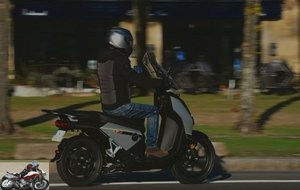 A look close to a thermal 125
A look close to a thermal 125
See the Supersoco Cpx scooter test in video
Conclusion
160 km of autonomy announced with two batteries, this is what to dream of and make the electric scooter a real alternative despite a high-end price which then reaches 5,290 euros (before premium and aid). Except that we appreciate being able to accelerate fully and that the duo must be able to be regular and this at normal speed and not in degraded mode. What if the two batteries could be recharged at the same time in one night, which is not necessarily the case. The electric brings us back to reality with a range closer to 100 kilometers when we are a duo and there are odds and a lot of fires requiring many stops and restarts. And charging from a standard outlet still takes too long. In fact, this only becomes viable by benefiting from possible aid for electricity (state, region especially for professionals with a premium of 520 euros for individuals minimum, some say 675 euros depending on the region or 2020 euros maximum for the pro thanks to the help of 1,500 euros) and by taking the model with a single battery to 4,290 euros. In which case, we lower the price to 3,770 euros. In any case, the premiums and help make the big difference now and it is necessary to do your calculation with the dealer beforehand. All of this confirms the CPx as an urban scooter mainly intended for short journeys with, however, the ability to take a peripheral if necessary..
Strong points
- silence
- protection
- overall finish
- amount of possible aid to reduce the price
Weak points
- autonomy
- no place under the saddle for a helmet
The Super Soco CPx technical sheet
Test conditions
- Itinerary: town + small varied roads + interurban highways
- Motorcycle mileage: 300 km
Related articles
-
Silence S02 electric scooter test
100 km / h, 127 km of autonomy … the true 125 thermal equivalence ? Daily test of the full version, High Speed (also available in limited version 45…
-
Test electric scooter Silence S01
100 km / h, 127 km of autonomy … the true 125 thermal equivalence ? Daily test Electric scooter models have exploded in recent years with an extended…
-
Rider 5000 electric scooter test
Daily test for one month of the 125 equivalent with a retro look 95 km / h, range 100 km, power 5 kW, battery 3.6 kWh In electric, there are machines…
-
Vespa Elettrica electric scooter test
Equivalent boosted wasp 125 100 km of range, 4 hours of full charge, 4 kW, 200 Nm of torque I love Vespas! The test started badly! Could I be objective!…
-
NIU M-Series: Sport or Pro Electricity is on the rise, if only to circulate freely in city centers which increasingly prohibit access to thermal energy….
-
The future of urban mobility Electricity is exploding, both at the level of car manufacturers who all have development plans with specific ranges and at…
-
Piaggio MP3 Yourban scooter test
The three-wheeled scooter 1100 euros cheaper than the standard MP3 Piaggio continues to decline its three-wheeled scooter and comes out after the…
-
GO! S1.4, GO! S2.4 and GO! S3.4 scooters comparison Electricity is everywhere! In development for several years now, electric vehicles are multiplying…
-
Piaggio MP3 Hybrid scooter test
Thermal / electric mix for MP3 Fashion is green and electric…. but electricity is not enough for large cities. Suddenly, the thermal / electrical mix…
-
When we make lightning speak In line with the i3 or even the i7, BMW is also entering the electric market with the C Evolution scooter: a logical choice…